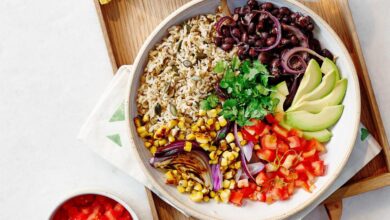Top Excuses for Not Cooking at Home & Solutions
We’ve all been there: staring into the abyss of our empty refrigerators, wishing for a delicious meal without the hassle of cooking. “Top Excuses for Not Cooking at Home and Solutions for Each” dives deep into the common reasons why we skip the kitchen, and offers practical, actionable solutions to overcome these hurdles.
From time constraints to lack of motivation, we’ll explore the psychological and logistical barriers to cooking and discover how to transform our kitchens into havens of deliciousness.
Whether you’re a seasoned chef or a complete novice, this guide is your roadmap to reclaiming the joy of cooking and savoring the satisfaction of a home-cooked meal. We’ll explore time-saving techniques, budget-friendly recipes, and tips for building confidence in the kitchen.
You’ll learn how to make cooking a more enjoyable and sustainable part of your life, all while indulging in flavorful and nutritious meals.
Lack of Cooking Skills: Top Excuses For Not Cooking At Home And Solutions For Each
Let’s face it, not everyone is a culinary master. Many people avoid cooking at home simply because they lack confidence in their skills. But the truth is, mastering basic cooking techniques isn’t as daunting as it might seem. It’s a journey that starts with small steps and grows with practice.
Common Cooking Skills People Struggle With
Learning how to cook is a journey that starts with understanding basic cooking techniques. While everyone has their own unique set of challenges, some common cooking skills that people often find difficult include:
- Measuring Ingredients:Accurately measuring ingredients is crucial for successful cooking. It’s important to know the difference between using measuring cups for liquids and dry ingredients, and to level off dry ingredients to avoid over-measuring.
- Using Knives Safely and Effectively:Knife skills are essential for chopping, slicing, and dicing ingredients. Mastering different knife techniques, like the ‘claw grip’ and the ‘bridge hold’, can improve precision and safety in the kitchen.
- Controlling Heat:Understanding how different heat levels affect cooking is essential. Learning to adjust the heat on your stovetop or oven to prevent burning or under-cooking food is a valuable skill.
- Timing and Doneness:Knowing when food is cooked to perfection requires experience. Learning to judge the doneness of different types of food, like meat or vegetables, through visual cues and using tools like thermometers, is key.
- Seasoning and Flavoring:Seasoning and flavoring are essential for creating delicious meals. Learning to use herbs, spices, and other flavoring agents effectively can transform a simple dish into something extraordinary.
Benefits of Learning Basic Cooking Techniques
Learning basic cooking techniques is more than just a culinary skill; it’s a valuable life skill that can benefit you in many ways. Here are some key advantages:
- Healthier Eating:Cooking at home allows you to control the ingredients and portion sizes, leading to healthier eating habits. You can reduce your intake of processed foods, added sugars, and unhealthy fats.
- Cost Savings:Cooking at home is often significantly cheaper than eating out or ordering takeout. You can stretch your food budget further and save money over time.
- Stress Relief:Cooking can be a therapeutic activity. Focusing on the process of preparing a meal can be a calming and mindful experience.
- Increased Creativity:Cooking allows you to experiment with different flavors and ingredients, fostering creativity in the kitchen. You can personalize recipes and create your own signature dishes.
- Improved Social Skills:Sharing home-cooked meals with friends and family can strengthen social bonds and create opportunities for connection.
Resources for Finding Beginner-Friendly Recipes and Cooking Tutorials
The internet is a treasure trove of resources for aspiring cooks. You can find countless beginner-friendly recipes and cooking tutorials online. Some popular platforms include:
- YouTube:YouTube is a great resource for finding step-by-step cooking tutorials from experienced chefs and home cooks. You can search for specific recipes or browse channels dedicated to beginner-friendly cooking.
- Food Blogs:Many food blogs offer easy-to-follow recipes and cooking tips for beginners. They often provide helpful explanations, photos, and tips for success.
- Cooking Apps:Several cooking apps provide recipes, meal planning tools, and grocery lists. Some even offer interactive tutorials and step-by-step instructions.
- Online Cooking Classes:Many online platforms offer virtual cooking classes for beginners. These classes provide structured learning experiences and personalized guidance from experienced instructors.
Tips for Building Confidence in the Kitchen
Building confidence in the kitchen takes time and practice. Here are some tips to help you on your culinary journey:
- Start Simple:Don’t overwhelm yourself with complex recipes. Begin with simple dishes that have a few ingredients and clear instructions.
- Practice Regularly:The more you cook, the more comfortable you’ll become in the kitchen. Aim to cook at least a few times a week to build your skills.
- Don’t Be Afraid to Experiment:Experimenting with different flavors and techniques is part of the fun of cooking. Don’t be afraid to try new things and see what you enjoy.
- Don’t Be Afraid to Ask for Help:If you’re struggling with a recipe or technique, don’t hesitate to ask for help from a friend, family member, or online community.
- Celebrate Your Successes:No matter how small, celebrate your cooking successes. This will boost your confidence and encourage you to keep cooking.
Financial Constraints
It’s no secret that food costs can be a significant barrier to cooking at home. The price of groceries has been steadily rising, and it can feel like you’re constantly being squeezed by the budget. But don’t despair! There are ways to find affordable ingredients and make cooking at home a financially feasible option.
Finding Affordable Ingredients
Finding affordable ingredients is key to making cooking at home a budget-friendly endeavor. Here are some strategies to help you stretch your grocery budget:
- Shop in Season: Seasonal produce is typically more affordable and often tastes better. Look for what’s in season at your local farmers’ market or grocery store. For example, you’ll find lower prices for tomatoes in the summer and apples in the fall.
- Choose Less Expensive Protein Sources: Meat and poultry can be costly, so consider using less expensive protein sources like beans, lentils, eggs, or tofu. These ingredients are packed with nutrients and can be used in a variety of dishes.
- Buy in Bulk: If you have the storage space, buying in bulk can often save you money. Look for deals on staples like rice, pasta, and canned goods. Just be sure to use what you buy before it goes bad.
- Utilize Store Brand Options: Don’t be afraid to explore store brand options for everyday items like milk, yogurt, and cereal. These brands often offer comparable quality at a lower price.
- Plan Your Meals: Before you head to the grocery store, take some time to plan your meals for the week. This will help you avoid impulse purchases and ensure you only buy what you need.
Grocery Shopping on a Budget
Budgeting for groceries can be a challenge, but with a little planning and smart shopping habits, you can save money without sacrificing quality.
We all have those days when cooking feels like a monumental task, but remember, mastering the kitchen can be a powerful tool for weight management. It’s all about making healthy choices and understanding the role hormones play in our weight loss journey.
If you’re struggling with cravings and finding it hard to stick to your goals, you might want to check out this article on 3 hormones to keep in mind for weight loss. Armed with this knowledge, you can better tackle those excuses for not cooking at home, like lack of time, and find creative solutions to whip up nutritious meals that support your weight loss goals.
- Create a Grocery List: Before you go shopping, create a detailed list of everything you need. This will help you stay focused and avoid buying unnecessary items.
- Compare Prices: Don’t be afraid to compare prices between different stores and brands. You may be surprised at the savings you can find.
- Take Advantage of Sales and Coupons: Look for sales and coupons on items you regularly purchase. Many stores offer digital coupons that you can load onto your loyalty card.
- Shop at Discount Grocery Stores: Discount grocery stores like Aldi and Lidl often offer lower prices on a wide variety of groceries.
- Consider Online Grocery Delivery: Some online grocery delivery services offer discounts and free delivery on your first order. This can be a convenient option if you have a busy schedule.
Maximizing Food Storage and Reducing Food Waste
Food waste is a significant problem, both financially and environmentally. By maximizing food storage and reducing waste, you can save money and reduce your environmental impact.
- Store Food Properly: Storing food properly helps it stay fresh longer. For example, keep fruits and vegetables in the refrigerator crisper drawer and store meat and poultry in the coldest part of the refrigerator.
- Use a Food Storage System: Label and date your food to help you keep track of what’s in your refrigerator and pantry. This will help you use older items first and avoid waste.
- Cook in Bulk: Cooking in bulk can be a great way to save time and money. Make extra portions and freeze them for later.
- Get Creative with Leftovers: Don’t throw away leftovers! Get creative and use them in other dishes. For example, leftover chicken can be used in a salad, soup, or stir-fry.
Budget-Friendly Recipes
There are plenty of budget-friendly recipes that are easy to prepare. Here are a few examples:
- Pasta with Tomato Sauce: A classic and affordable dish that can be made with pantry staples like pasta, canned tomatoes, and herbs.
- Bean and Rice Burrito Bowls: A hearty and healthy meal that can be made with black beans, rice, and your favorite toppings like salsa, avocado, and cheese.
- Lentil Soup: A filling and nutritious soup that is packed with protein and fiber.
- Sheet Pan Chicken and Vegetables: A quick and easy meal that can be made with chicken, vegetables, and a simple seasoning.
- Chicken Noodle Soup: A comforting and nourishing soup that is perfect for a cold day.
Lack of Motivation
Let’s face it, sometimes the last thing we want to do after a long day is spend more time in the kitchen. But the lack of motivation to cook can be a real roadblock to healthy eating and enjoying delicious home-cooked meals.
This section explores the psychological factors that contribute to this lack of motivation, provides tips for finding inspiration and making cooking enjoyable, and shares examples of healthy and delicious recipes that are quick and easy to prepare.
The Psychological Factors Contributing to a Lack of Motivation
The reasons why we lack motivation to cook are often rooted in our psychology. Feeling overwhelmed by the prospect of cooking, a perception that it takes too much time, and even the fear of failure can all contribute to our lack of enthusiasm.
Let’s be honest, sometimes the idea of cooking after a long day can feel overwhelming. “No time,” “too complicated,” and “I’m just not in the mood” are common excuses. But what if I told you there’s a delicious and easy solution?
Try out these banana oat Greek yogurt pancakes – they’re packed with flavor and require minimal effort. With simple ingredients and a quick prep time, you can conquer those excuses and enjoy a healthy, homemade meal in no time!
Finding Inspiration and Making Cooking Enjoyable, Top excuses for not cooking at home and solutions for each
To overcome this lack of motivation, we need to find ways to make cooking feel less like a chore and more like a creative outlet. This means finding inspiration, making the process enjoyable, and embracing the benefits of cooking for ourselves.
We all have those nights when cooking feels like a chore – “I’m too tired,” “There’s nothing in the fridge,” or “Takeout is just so easy.” But with a little planning and a sprinkle of motivation, conquering these excuses is totally doable! Remember, building a new habit takes time and effort, so check out this article on how to stay motivated when starting a new habit for some helpful tips.
Once you’ve got the motivation down, you can start tackling those excuses with simple solutions like meal prepping, stocking your pantry with healthy staples, or even trying a new recipe that gets you excited to cook.
Here are some tips to make cooking more appealing:
Tips for Finding Inspiration
- Browse cookbooks and food blogs:Immerse yourself in the world of culinary creativity. Discover new recipes, techniques, and cuisines that spark your interest.
- Follow food-related accounts on social media:Social media platforms are a treasure trove of culinary inspiration. Follow chefs, food bloggers, and home cooks who share their recipes and cooking tips.
- Watch cooking shows:Get inspired by watching skilled chefs in action. You might learn new techniques, discover new ingredients, and even get ideas for your next meal.
Making Cooking Enjoyable
- Create a positive cooking environment:A clean and organized kitchen can make a big difference in your motivation. Put on some music, light candles, or open a window to let in fresh air.
- Involve friends or family:Cooking with others can make the process more fun and social. Plan a potluck, host a cooking party, or simply cook together with a loved one.
- Experiment with new flavors and ingredients:Don’t be afraid to step outside of your comfort zone and try new things. You might discover new favorites!
Quick and Easy Recipes
Here are some quick and easy recipe ideas that are perfect for busy weeknights:
- One-pan roasted vegetables:Toss your favorite vegetables with olive oil, salt, and pepper, and roast them in a single pan for a healthy and flavorful side dish.
- Sheet pan chicken and vegetables:This is a great option for a complete meal. Simply place chicken breasts and vegetables on a baking sheet, drizzle with olive oil and seasonings, and bake until cooked through.
- Pasta salad:Pasta salad is a versatile dish that can be customized with your favorite ingredients. Choose your favorite pasta, vegetables, and dressing, and enjoy a delicious and easy meal.
Cooking as Self-Care and Stress Relief
Cooking can be a form of self-care and stress relief. The act of preparing a meal can be a mindful experience, allowing you to focus on the present moment and connect with your senses. The aroma of herbs and spices, the sound of chopping vegetables, and the feel of kneading dough can all be calming and therapeutic.
“Cooking is a form of self-care that nourishes the body and the soul.”
Unknown
Convenience of Restaurant Food
Let’s face it, sometimes the thought of cooking after a long day is just too much. Ordering takeout or dining out seems like the easiest and most convenient option. Restaurants offer a wide variety of cuisines, prepared by professional chefs, and delivered right to your door or enjoyed in a welcoming atmosphere.
But is this convenience really worth the cost?
Nutritional Value and Cost Comparison
While restaurant meals can be delicious and convenient, they often come with a higher price tag and may not be as nutritionally balanced as home-cooked meals. Restaurant meals are typically higher in calories, fat, sodium, and sugar compared to home-cooked meals.
For example, a typical restaurant burger and fries meal can contain over 1000 calories, 50 grams of fat, and 2000 milligrams of sodium. In contrast, a homemade chicken breast with steamed vegetables and a side of brown rice can be a much healthier option, containing fewer calories, less fat, and less sodium.
Additionally, the cost of restaurant meals can quickly add up. Eating out frequently can put a significant strain on your budget, especially if you are ordering for multiple people.
Potential Health Risks Associated with Frequent Restaurant Dining
While occasional restaurant dining is fine, frequent restaurant meals can pose certain health risks. The high sodium content in many restaurant meals can contribute to high blood pressure, a major risk factor for heart disease and stroke. The high levels of saturated and trans fats can also increase the risk of heart disease.
Furthermore, the use of processed ingredients, excessive amounts of sugar, and large portion sizes can contribute to weight gain, diabetes, and other chronic health conditions.
Making Home-Cooked Meals More Convenient and Appealing
It is possible to enjoy delicious and nutritious meals at home without sacrificing convenience. Here are some tips to make home cooking easier and more enjoyable:
- Plan your meals in advance:This can help you save time and money by avoiding last-minute takeout orders. You can plan your meals for the week, make a grocery list, and even prepare some ingredients in advance.
- Cook in bulk:Cooking a large batch of food can save you time during the week. You can freeze portions for later use, or have leftovers for lunch the next day.
- Embrace simple recipes:There are countless simple and quick recipes available online and in cookbooks. You don’t need to be a gourmet chef to create healthy and delicious meals at home.
- Experiment with new flavors and cuisines:Trying new recipes can keep home cooking interesting and prevent meal fatigue. There are many resources available online and in cookbooks to help you explore different cuisines and cooking techniques.
Epilogue
From overcoming time constraints to finding culinary inspiration, this exploration of excuses and solutions aims to empower you to embrace the kitchen as a source of creativity and nourishment. Remember, cooking doesn’t have to be complicated or time-consuming. By understanding the barriers and implementing the strategies Artikeld here, you can unlock the potential of your kitchen and create delicious, fulfilling meals that nourish your body and soul.





